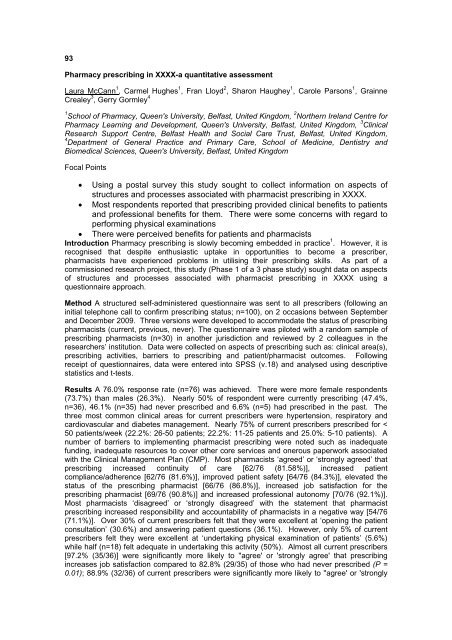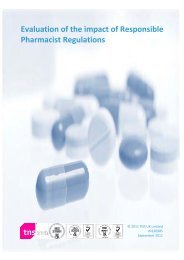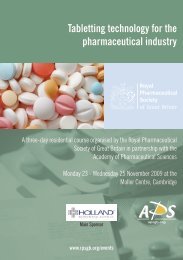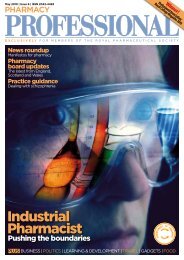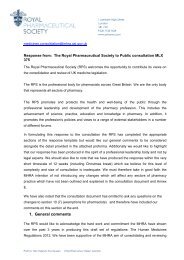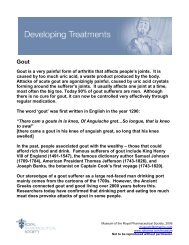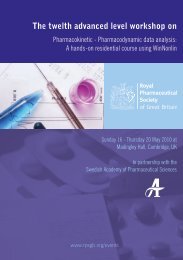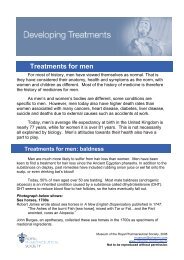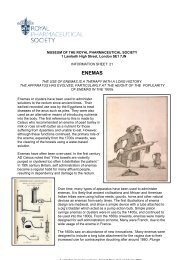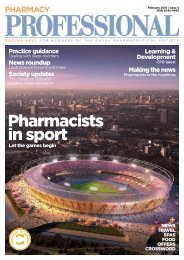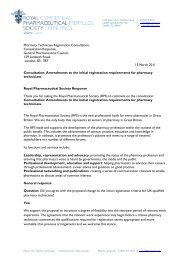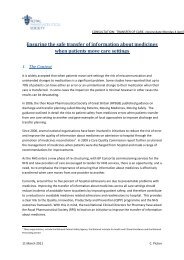RPS Conference 2010, Abstracts 2010 - Royal Pharmaceutical Society
RPS Conference 2010, Abstracts 2010 - Royal Pharmaceutical Society
RPS Conference 2010, Abstracts 2010 - Royal Pharmaceutical Society
You also want an ePaper? Increase the reach of your titles
YUMPU automatically turns print PDFs into web optimized ePapers that Google loves.
93<br />
Pharmacy prescribing in XXXX-a quantitative assessment<br />
Laura McCann 1 , Carmel Hughes 1 , Fran Lloyd 2 , Sharon Haughey 1 , Carole Parsons 1 , Grainne<br />
Crealey 3 , Gerry Gormley 4<br />
1 School of Pharmacy, Queen's University, Belfast, United Kingdom, 2 Northern Ireland Centre for<br />
Pharmacy Learning and Development, Queen's University, Belfast, United Kingdom, 3 Clinical<br />
Research Support Centre, Belfast Health and Social Care Trust, Belfast, United Kingdom,<br />
4 Department of General Practice and Primary Care, School of Medicine, Dentistry and<br />
Biomedical Sciences, Queen's University, Belfast, United Kingdom<br />
Focal Points<br />
• Using a postal survey this study sought to collect information on aspects of<br />
structures and processes associated with pharmacist prescribing in XXXX.<br />
• Most respondents reported that prescribing provided clinical benefits to patients<br />
and professional benefits for them. There were some concerns with regard to<br />
performing physical examinations<br />
• There were perceived benefits for patients and pharmacists<br />
Introduction Pharmacy prescribing is slowly becoming embedded in practice 1 . However, it is<br />
recognised that despite enthusiastic uptake in opportunities to become a prescriber,<br />
pharmacists have experienced problems in utilising their prescribing skills. As part of a<br />
commissioned research project, this study (Phase 1 of a 3 phase study) sought data on aspects<br />
of structures and processes associated with pharmacist prescribing in XXXX using a<br />
questionnaire approach.<br />
Method A structured self-administered questionnaire was sent to all prescribers (following an<br />
initial telephone call to confirm prescribing status; n=100), on 2 occasions between September<br />
and December 2009. Three versions were developed to accommodate the status of prescribing<br />
pharmacists (current, previous, never). The questionnaire was piloted with a random sample of<br />
prescribing pharmacists (n=30) in another jurisdiction and reviewed by 2 colleagues in the<br />
researchers’ institution. Data were collected on aspects of prescribing such as: clinical area(s),<br />
prescribing activities, barriers to prescribing and patient/pharmacist outcomes. Following<br />
receipt of questionnaires, data were entered into SPSS (v.18) and analysed using descriptive<br />
statistics and t-tests.<br />
Results A 76.0% response rate (n=76) was achieved. There were more female respondents<br />
(73.7%) than males (26.3%). Nearly 50% of respondent were currently prescribing (47.4%,<br />
n=36), 46.1% (n=35) had never prescribed and 6.6% (n=5) had prescribed in the past. The<br />
three most common clinical areas for current prescribers were hypertension, respiratory and<br />
cardiovascular and diabetes management. Nearly 75% of current prescribers prescribed for <<br />
50 patients/week (22.2%: 26-50 patients; 22.2%: 11-25 patients and 25.0%: 5-10 patients). A<br />
number of barriers to implementing pharmacist prescribing were noted such as inadequate<br />
funding, inadequate resources to cover other core services and onerous paperwork associated<br />
with the Clinical Management Plan (CMP). Most pharmacists ‘agreed’ or ‘strongly agreed’ that<br />
prescribing increased continuity of care [62/76 (81.58%)], increased patient<br />
compliance/adherence [62/76 (81.6%)], improved patient safety [64/76 (84.3%)], elevated the<br />
status of the prescribing pharmacist [66/76 (86.8%)], increased job satisfaction for the<br />
prescribing pharmacist [69/76 (90.8%)] and increased professional autonomy [70/76 (92.1%)].<br />
Most pharmacists ‘disagreed’ or ‘strongly disagreed’ with the statement that pharmacist<br />
prescribing increased responsibility and accountability of pharmacists in a negative way [54/76<br />
(71.1%)]. Over 30% of current prescribers felt that they were excellent at ‘opening the patient<br />
consultation’ (30.6%) and answering patient questions (36.1%). However, only 5% of current<br />
prescribers felt they were excellent at ‘undertaking physical examination of patients’ (5.6%)<br />
while half (n=18) felt adequate in undertaking this activity (50%). Almost all current prescribers<br />
[97.2% (35/36)] were significantly more likely to ''agree' or 'strongly agree' that prescribing<br />
increases job satisfaction compared to 82.8% (29/35) of those who had never prescribed (P =<br />
0.01); 88.9% (32/36) of current prescribers were significantly more likely to ''agree' or 'strongly


